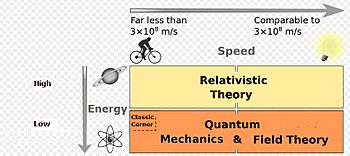Classical physics facts for kids
Classical physics refers to theories of physics that predate modern, theories. As such, the definition of a classical theory depends on context. Classical physical concepts are often used when modern theories are unnecessarily complex for a particular situation.
Contents
Overview
Classical theory has at least two distinct meanings in physics. In the context of quantum mechanics, classical theory refers to theories of physics that do not use the quantisation paradigm, which includes classical mechanics and relativity. Likewise, classical field theories, such as general relativity and classical electromagnetism, are those that do not use quantum mechanics. In the context of general and special relativity, classical theories are those that obey Galilean relativity.
Areas of classical physics
- Mechanics (how levers help lift things, cars keep moving after the engine is turned off, etc.)
- Thermodynamics (why we experience some things as hot and other things as cold, why it takes longer to heat water than air, etc.)
- Electricity (why rubbing one object with another can produce a static charge, why electrons move through wires, why lightning can span immense distances, etc.)
- Magnetism (why compass needles point to the north and south poles, why nails wrapped around and around with insulated wire will act as magnets when a direct current is passed through the wire, etc.)
- Optics (why sunlight that passes through raindrops can produce a rainbow, why prism bend light and make a spectrum like the rainbow, why lenses can magnify things, how to make powerful telescopes with or without using lenses, etc.)
Among the branches of theory included in classical physics are:
- Classical mechanics
- Newton's laws of motion
- Classical Lagrangian and Hamiltonian
- Classical electrodynamics (Maxwell's Equations)
- Classical thermodynamics
- Special relativity and general relativity
- Classical chaos theory and nonlinear dynamics
Comparison with modern physics
In contrast to classical physics, "modern physics" is a slightly looser term which may refer to just quantum physics or to 20th and 21st century physics in general. Modern physics includes quantum theory and relativity, when applicable.
A physical system can be described by classical physics when it satisfies conditions such that the laws of classical physics are approximately valid. In practice, physical objects ranging from those larger than atoms and molecules, to objects in the macroscopic and astronomical realm, can be well-described (understood) with classical mechanics.
Computer modeling and manual calculation, modern and classic comparison
Today a computer performs millions of arithmetic operations in seconds to solve a classical differential equation, while Newton (one of the fathers of the differential calculus) would take hours to solve the same equation by manual calculation.
See also
 In Spanish: Física clásica para niños
In Spanish: Física clásica para niños



